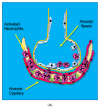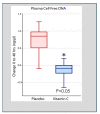Vitamin C: Rationale for Its Use in Sepsis-Induced Acute Respiratory Distress Syndrome (ARDS)
- PMID: 38247519
- PMCID: PMC10812524
- DOI: 10.3390/antiox13010095
Vitamin C: Rationale for Its Use in Sepsis-Induced Acute Respiratory Distress Syndrome (ARDS)
Abstract
Acute respiratory distress syndrome (ARDS) is a life-threatening event that occurs in patients suffering from bacterial, fungal, or viral sepsis. Research performed over the last five decades showed that ARDS is a consequence of severe unrestrained systemic inflammation, which leads to injury of the lung's microvasculature and alveolar epithelium. ARDS leads to acute hypoxic/hypercapnic respiratory failure and death in a significant number of patients hospitalized in intensive care units worldwide. Basic and clinical research performed during the time since ARDS was first described has been unable to construct a pharmacological agent that will combat the inflammatory fire leading to ARDS. In-depth studies of the molecular pharmacology of vitamin C indicate that it can serve as a potent anti-inflammatory agent capable of attenuating the pathobiological events that lead to acute injury of the lungs and other body organs. This analysis of vitamin C's role in the treatment of ARDS includes a focused systematic review of the literature relevant to the molecular physiology of vitamin C and to the past performance of clinical trials using the agent.
Keywords: ARDS; NETosis; cell-free hemoglobin (CFH); lung vascular injury; neutrophil extracellular traps (NETS); reactive oxygen species (ROS); sepsis; sodium vitamin C transporters SVCT 1 and 2; vitamin C.
Conflict of interest statement
The authors declare no conflict of interest.
Figures








References
-
- Bellani G., Laffey J.G., Pham T., Fan E., Brochard L., Esteban A., Gattinoni L., van Haren F., Larsson A., McAuley D.F., et al. Epidemiology, Patterns of Care, and Mortality for Patients with Acute Respiratory Distress Syndrome in Intensive Care Units in 50 Countries. JAMA. 2016;315:788–800. doi: 10.1001/jama.2016.0291. - DOI - PubMed
-
- Auriemma C.L., Zhuo H., Delucchi K., Deiss T., Liu T., Jauregui A., Ke S., Vessel K., Lippi M., Seeley E., et al. Acute respiratory distress syndrome-attributable mortality in critically ill patients with sepsis. Intensive Care Med. 2020;46:1222–1231. doi: 10.1007/s00134-020-06010-9. - DOI - PMC - PubMed
Publication types
Grants and funding
LinkOut - more resources
Full Text Sources
Miscellaneous

